Atkinson K. An Introduction to Numerical Analysis
Подождите немного. Документ загружается.

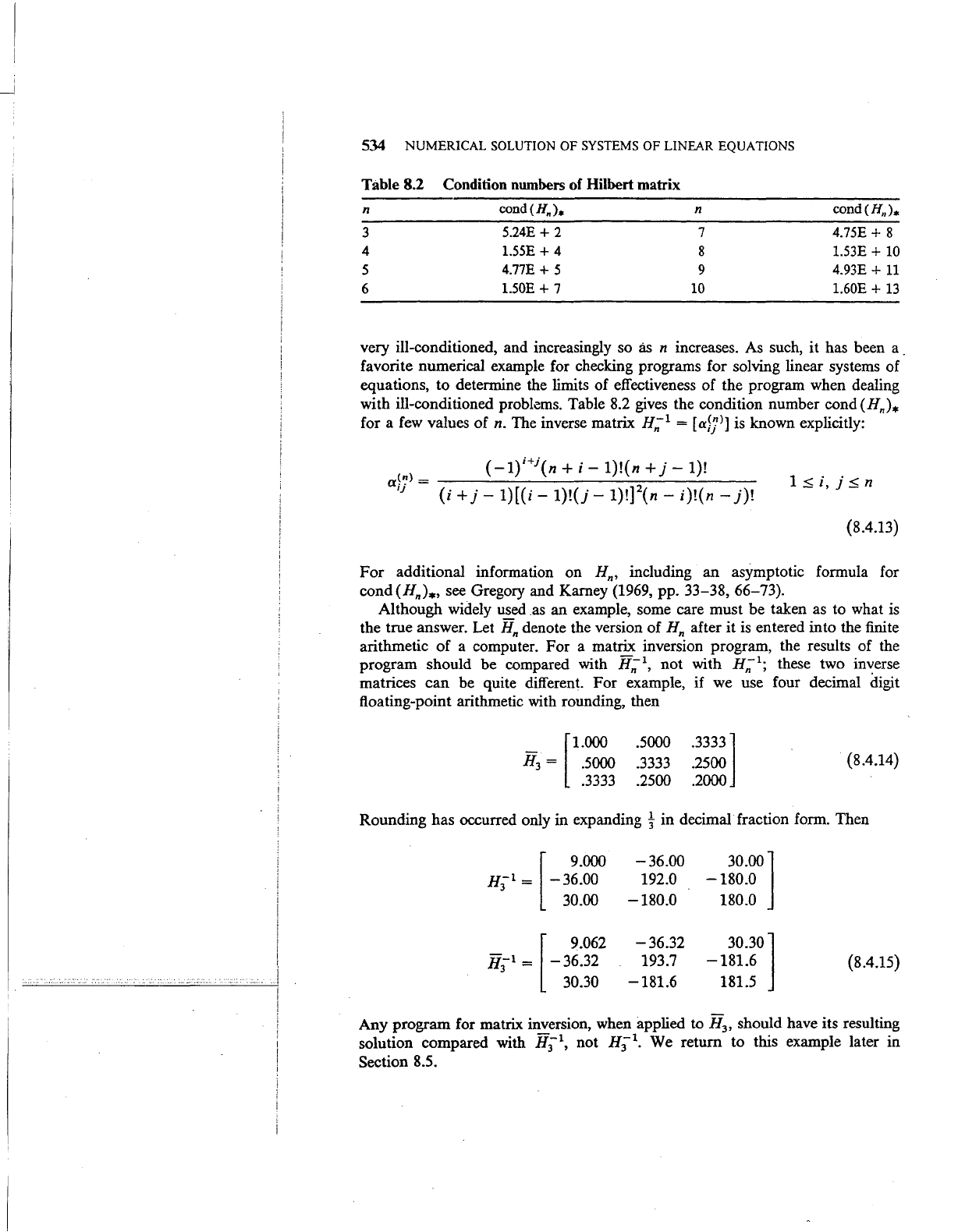
'
_j
534
NUMERICAL SOLUTION OF SYSTEMS OF LINEAR EQUATIONS
Table 8.2 Condition numbers of Hilbert matrix
n
cond(Hn)*
n
cond(H,).
3
5.24E + 2 7
4.75E
+ 8
4
1.55E
+ 4 8
1.53E
+ 10
5
4.77E
+ 5
9 4.93E
+
11
6 1.50E + 7
10
1.60E
+
13
very ill-conditioned, and increasingly so
as
n increases. As such,
it
has been
a_
favorite numerical example for checking programs for solving linear systems of
equations,
to
determine the limits
of
effectiveness
of
the program when dealing
with ill-conditioned
probkms. Table 8.2 gives the condition number cond
(H,)*
for a few values
of
n. The inverse matrix H,-
1
=
[a~j>]
is known explicitly:
{
-1)Hi(n
+ i
-1)!(n
+ j
-1)!
a\~>=--------------------~------------
'1
(i
+
j-
1)[(;-
1)!{J-
1)!]
2
{n-
i)!{n-
j)!
1::::;
i,
j::::; n
{8.4.13)
For
additional information
on
H,,
including
an
asymptotic formula for
cond(H,).,
see Gregory and Karney (1969, pp. 33-38, 66-73).
Although widely used
.as
an
example, some care
must
be
taken as to what is
the true answer. Let
Ii, denote the version of
H,
after
it
is entered into the finite
arithmetic
of
a computer.
For
a matrix inversion program, the results of the
program should
be
compared with
H;;\
not
with
H;;
1
;
these two inverse
matrices
can
be quite different.
For
example, if we use four decimal digit
floating-point arithmetic with rounding, then
[
1.000
H3
= .5000
.3333
.5000
.3333
.2500
.3333]
.2500
.2000
{8.4.14)
Rounding has occurred only in expanding t in decimal· fraction form. Then
[m
-36.00
30.00 l
H
3
-
1
=
-36.00
192.0
-180.0
30.00
-180.0
180.0
[
9.062
-36.32
30.30 l
H
3
-
1
=
-36.32
193.7
-181.6
{8.4.15)
30.30
-181.6
181.5
Any
program for matrix inversion, when applied to H
3
,
should have its resulting
solution compared with
H)\
not
H)
1
•
We return to this example later in
Section
8.5.
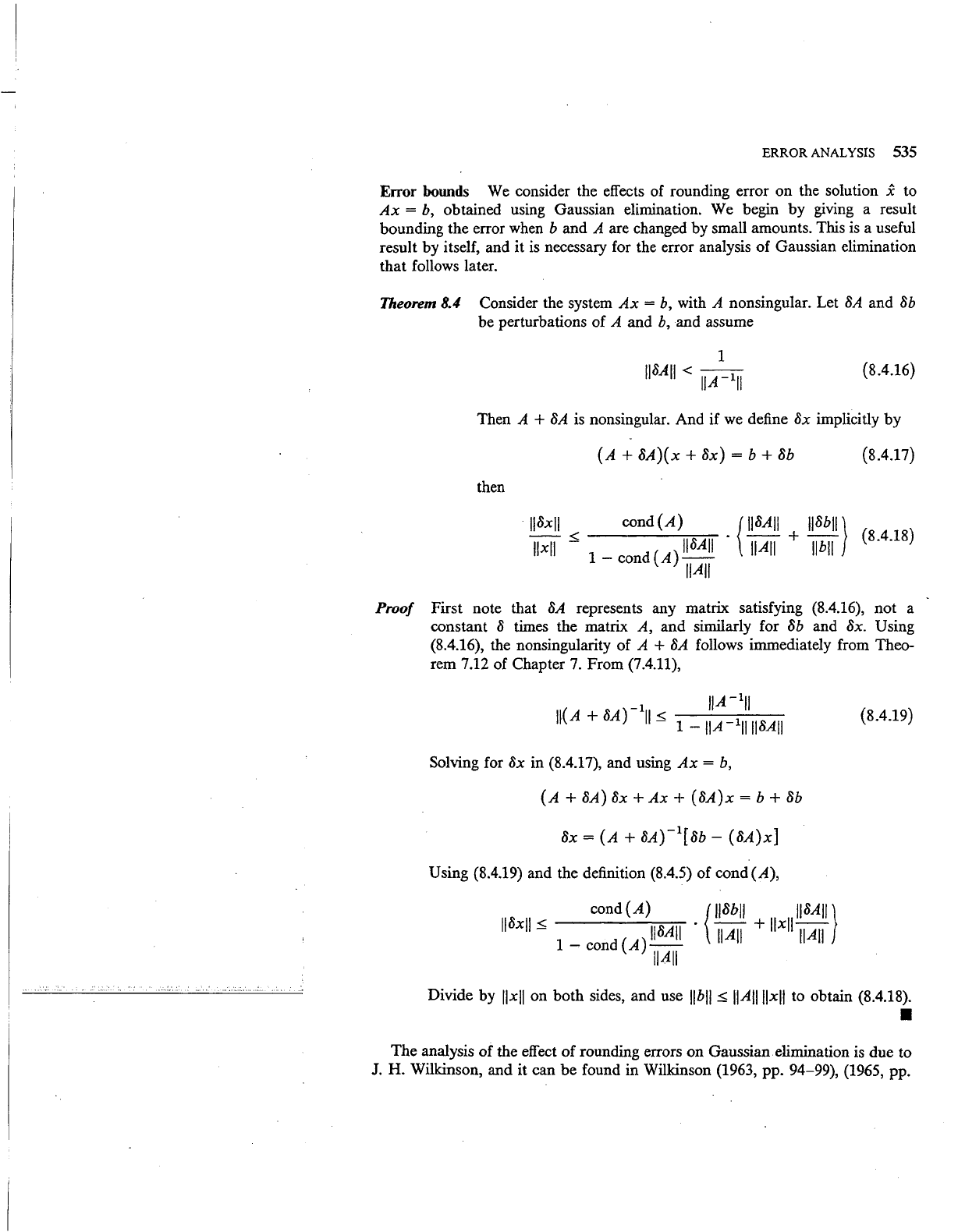
ERROR
ANALYSIS 535
Error
bounds We consider the effects of rounding
error
on
the solution x to
Ax=
b,
obtained using Gaussian elimination.
We
begin
by
giving a result
bounding
the
error when b
and
A are changed
by
small amounts. This is a useful
result
by
itself,
and
it
is necessary for the
error
analysis
of
Gaussian elimination
that
follows later.
Theorem 8.4 Consider the system Ax = b, with A nonsingular. Let 8A
and
8b
be
perturbations
of
A
and
b,
and
assume
(8.4.16)
Then
A +
8A
is nonsingular.
And
if
we define llx implicitly
by
(A + BA)(x
+ox)=
b +
llb
(8.4.17)
then
·
_llox_ll
<
__
co_n_d_(A_)....,..,...,.,...
. {
llllAII
+
118hll}
(
8
.4.
18
)
llxll
-
IIMII
IIAII
llhll
1-
cond{A)T!Ail
Proof
First
note
that
8A
represents
any
matrix satisfying (8.4.16),
not
a
constant
8 times the matrix
A,
and
similarly
for
llb
and
llx. Using
(8.4.16), the nonsingularity
of
A +
8A
follows immediately from Theo-
rem
7.12
of
Chapter
7.
From
(7.4.11),
II(
A
BA)-111
IIA-111
+
~
1
-IIA-
1
11118AII
Solving for llx
in
(8.4.17),
and
using Ax =
b,
(A + llA)
ox+
Ax+
(llA)x = b +
ob
ox=
(A+
oA)-
1
[ob-
{oA)x]
Using (8.4.19)
and
the definition (8.4.5)
of
cond(A),
cond(A)
{llllbll
!loAII}
llllxll
~
IIMII
.
IIAII
+ llxliT!Ail
1-
cond{A)-
IIAII
(8.4.19)
Divide
by
llxll
on
both
sides,
and
use
llbll
~
IIAllllxll to obtain (8.4.18) .
•
The
analysis
of
the effect
of
rounding errors
on
Gaussian
elimination is
due
to
J.
H.
Wilkinson,
and
it
can
be
found
in
Wilkinson (1963,
pp.
94-99), (1965, pp.
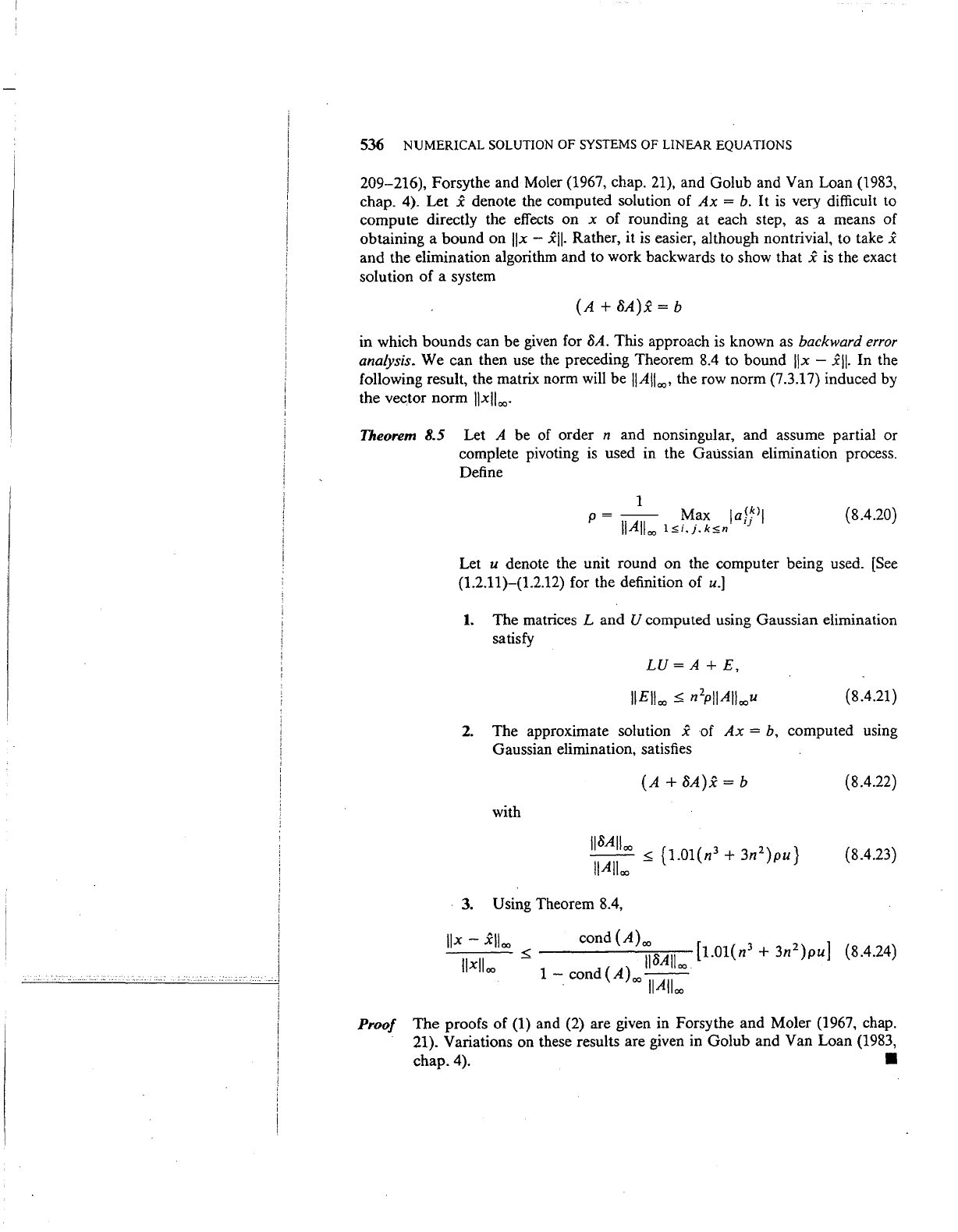
536
NUMERICAL SOLUTION OF SYSTEMS OF LINEAR EQUATIONS
209-216), Forsythe and Moler (1967, chap.
21),
and Golub and Van Loan
(1983,
chap. 4). Let
.X
denote the computed solution of
Ax
= b. It
is
very difficult to
compute directly the
effects
on x of rounding at each step, as a means of
obtaining a bound on
llx
-
.Xjj.
Rather, it
is
easier, although nontrivial, to take
.X
and the elimination algorithm and to work backwards to show that
.X
is
the exact
solution of a system
(A+
8A)x
= b
in which bounds can be
given
for
8A.
This approach
is
known as
backward
error
analysis. We can then
use
the preceding Theorem
8.4
to bound
llx-
.XII.
In the
following result, the matrix norm
will
be
IIAIIoo•
the row norm (7.3.17) induced by
the vector norm
llxllw
Theorem 8.5 Let A be of order n and nonsingular, and assume partial or
complete pivoting
is
used in the Gaussian elimination process.
Define
1
p =
--
Max
jafk>l
IIAIIoo
l:s;i.j.ks,n
1
(8.4.20)
Let u denote the unit round on the computer being used.
[See
(1.2.11)-(1.2.12) for the definition of
u.)
1.
The matrices L and U computed using Gaussian elimination
satisfy
LU=A+E,
IIEIIoo
~
n
2
PIIA11oou
(8.4.21)
2.
The approximate solution
.X
of
Ax
= b, computed using
Gaussian elimination, satisfies
(A+
8A)x
= b
(8.4.22)
with
(8.4.23)
3.
Using Theorem
8.4,
cond
(A)oo
3 2
~
-----
1
::-::
18
:--:-A-:-;-IIoo-[1.01(n
+
3n
)pu]
1-
cond
(A)
00
IIAIIoo
(8.4.24)
Proof The proofs of
(1)
and (2) are given in Forsythe and Moler
(1967,
chap.
21). Variations on these results are given in Golub and Van Loan
(1983,
chap. 4). •
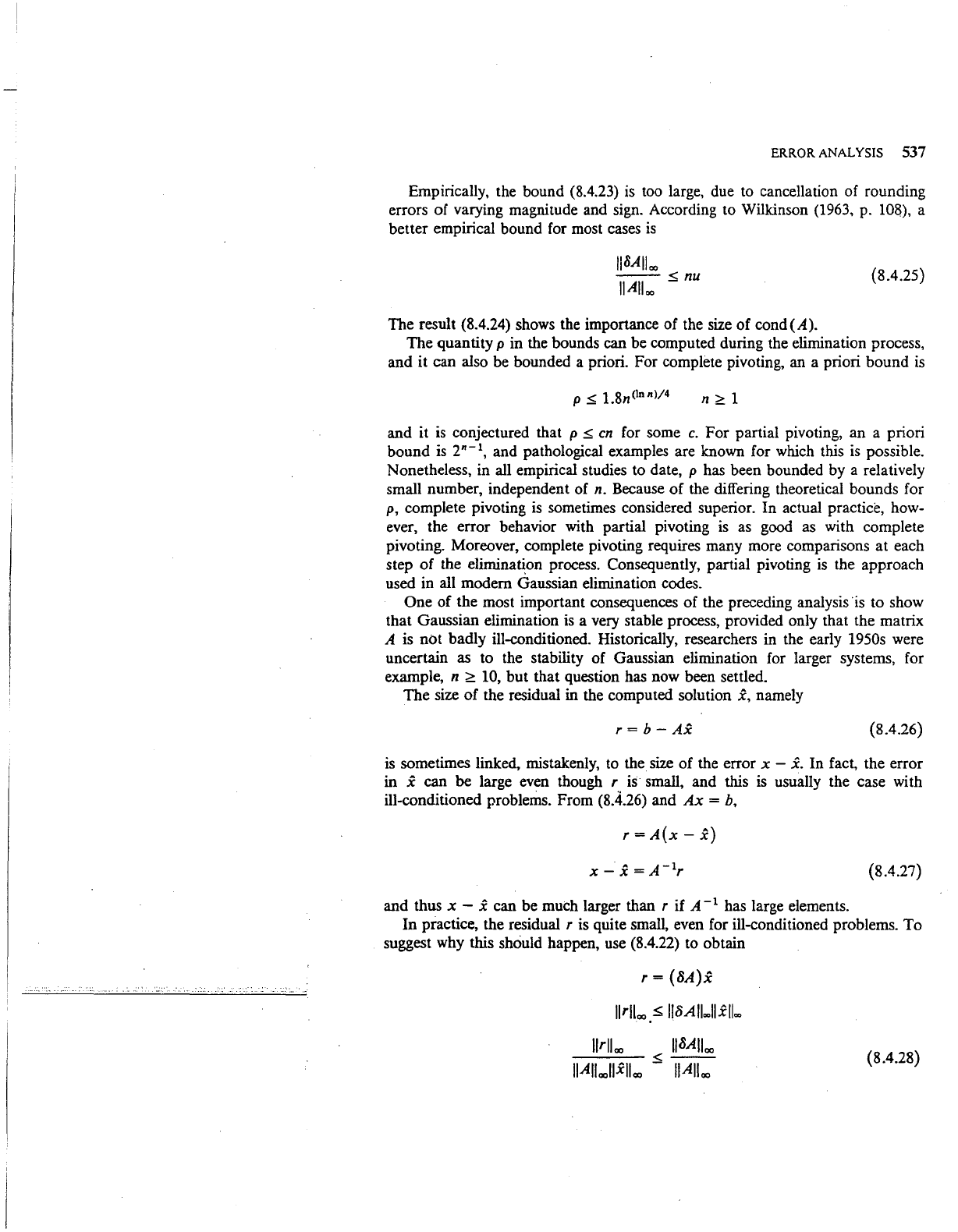
ERROR
ANALYSIS
537
Empirically, the bound (8.4.23)
is
too
large, due
to
cancellation of rounding
errors of varying magnitude and sign. According to Wilkinson
(1963,
p.
108),
a
better empirical bound for most cases
is
{8.4.25)
The result (8.4.24) shows the importance of the size of cond (A).
The quantity p in the bounds can be computed during the elimination process,
and it can also be bounded a priori. For complete pivoting, an a priori bound
is
p
::s;
1.8n(ln
n)/4
n~1
and it
is
conjectured that p
::s;
en
for some
c.
For partial pivoting, an a priori
bound
is
2n-l, and pathological examples are known for which this
is
possible.
Nonetheless, in all empirical studies to date,
p has been bounded
by
a relatively
small number, independent of
n. Because
of
the differing theoretical bounds for
p, complete pivoting
is
sometimes considered superior. In actual practice, how-
ever, the error behavior with partial pivoting
is
as
good as with complete
pivoting. Moreover, complete pivoting requires many more comparisons at each
step of the
eliminatipn process. Consequently, partial pivoting
is
the approach
used
in
all modem Gaussian elimination codes.
One of the most important consequences of the preceding analysis 'is to show
that Gaussian elimination
is
a very stable process, provided only that the matrix
A is not badly ill-conditioned. Historically, researchers in the early 1950s were
uncertain
as
to the stability of Gaussian elimination for larger systems, for
example,
n
~
10,
but that question has now been settled.
The size
of
the residual in the computed solution
x,
namely
r =
b-
Ax
{8.4.26)
is
sometimes linked, mistakenly,
to
thesize of the error x -.X. In fact, the error
in
x can be large even though r is small, and this
is
usually the case with
ill-conditioned problems. From
(8.4.26) and
Ax
=
b,
r=A(x-x)
(8.4.27)
and thus x - x can be much larger than r if A
-l
has large elements.
In practice, the residual
r is quite small, even for ill-conditioned problems. To
suggest
why
this should happen,
use
(8.4.22) to obtain
r = (8A)x
llrU""
.::s::
IISAII..,IIxll..,
Hrllco
118AIIco
----~--
<
-----
IIAIIcollxllco
-
IIAII""
(8.4.28)
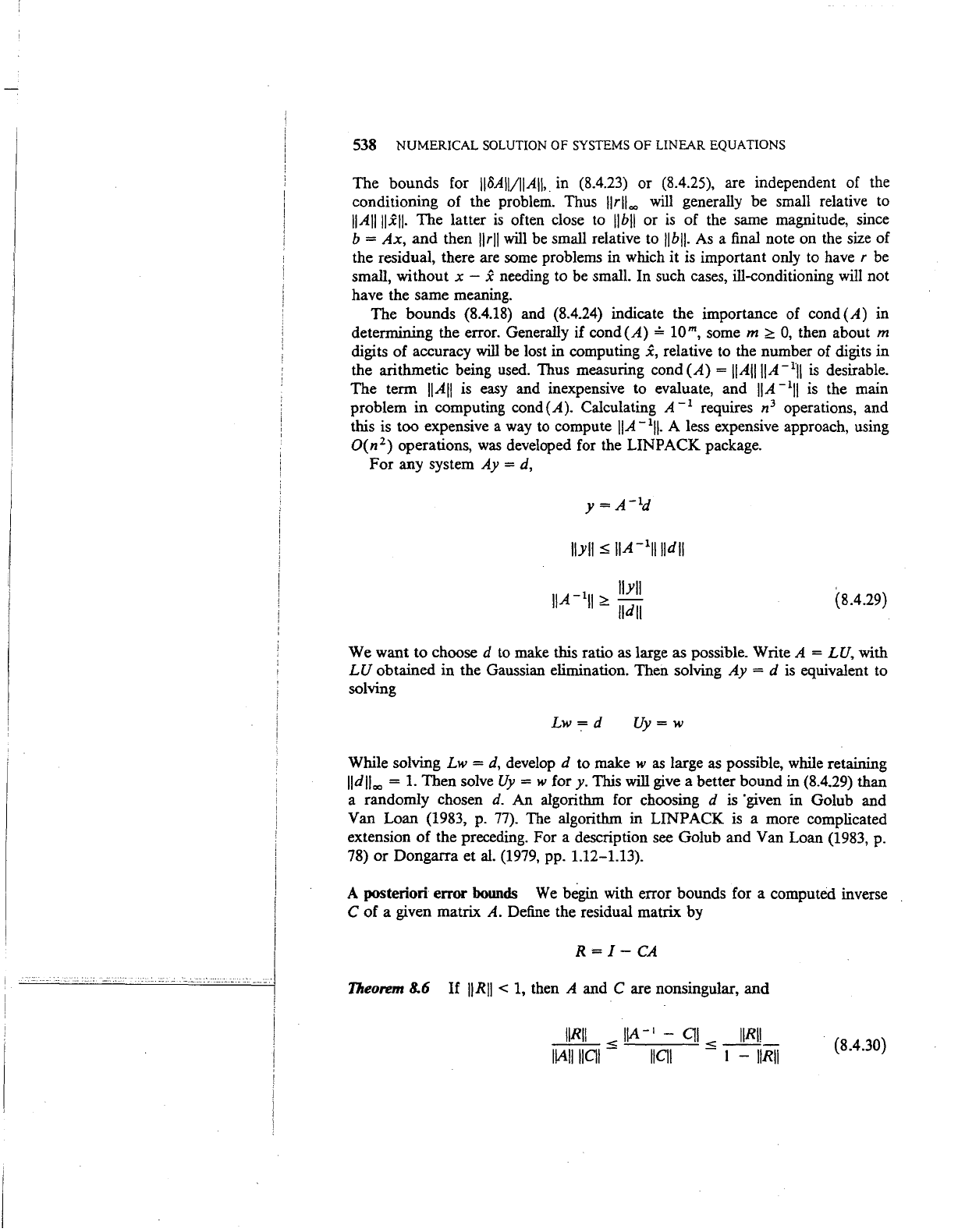
.
:·
·::
.....
'-~
.... :.: .
~
..
:
...
:::.
·.:
.....
·:
..
~
..
:::
: .
..:
-'
_:_
·~:·.
:
...
·-·.
. . . . . . .
..
'
538 NUMERICAL SOLUTION OF SYSTEMS
OF
LINEAR EQUATIONS
The bounds for
iic5Ail/IIAII,.
in (8.4.23) or (8.4.25), are independent of the
conditioning of the problem. Thus
llrllco
will
generally be small relative to
IIAIIIIxll.
The latter
is
often close
to
llbll
or
is
of the same magnitude, since
b
=Ax,
and then
llrll
will
be
small relative
to
llbll.
As
a final note on the
size
of
the residual, there are some problems in which it
is
important only
to
have r be
small, without
x - x needing to be small. In such cases, ill-conditioning
will
not
have the same meaning.
The bounds
(8.4.18) and (8.4.24) indicate the importance of cond (A) in
determining the error. Generally if
cond(A),;.
10m,
some m;;::
0,
then about m
digits of accuracy will be lost in computing
x,
relative
to
the number of digits in
the arithmetic being
used.
Thus measuring cond (A) =
II
All
II
A -til
is
desirable.
The term
IIAII
is
easy
and inexpensive to evaluate, and
IIA
-
1
11
is
the main
problem in computing cond (A). Calculating
A
-I
requires n
3
operations, and
this is too expensive a way
to
compute
IIA
-
1
11.
A less expensive approach, using
O(n
2
)
operations,
was
developed for the
UNPACK
package.
For
any system
Ay
= d,
IIYII
~
IIA
-
1
lllldll
IIA-
1
11
>
~
-
!ldll
{8.4.29)
We want to choose d
to
make this ratio as large as possible. Write A =
LU,
with
LU
obtained in the Gaussian elimination. Then solving
Ay
= d
is
equivalent to
solving
Lw=d
Uy=w
While solving
Lw
= d, develop d to make w
as
large
as
possible, while retaining
lid
II""
= 1. Then solve
Uy
= w for
y.
This
will
give a better bound in (8.4.29) than
a randomly chosen
d.
An algorithm for choosing d is
"given
in Golub and
Van Loan (1983,
p.
77). The algorithm in
UNPACK
is
a more complicated
extension of the preceding. For a description see Golub and
Van Loan (1983, p.
78)
or
Dongarra et
al.
(1979, pp. 1.12-1.13).
A posteriori
error
bounds
We
begin with error bounds for a computed inverse
C of a given matrix A. Define the residual matrix by
Theorem 8.6
R=I-
CA
If
IIRII
< 1, then A and C are nonsingular, and
___:;_IIR...::.II_
<
IIA
_,
-
en
<
_IIR_I!_
IIAIIIICII
-
IICII
- t -
IIRII
(8.4.30)
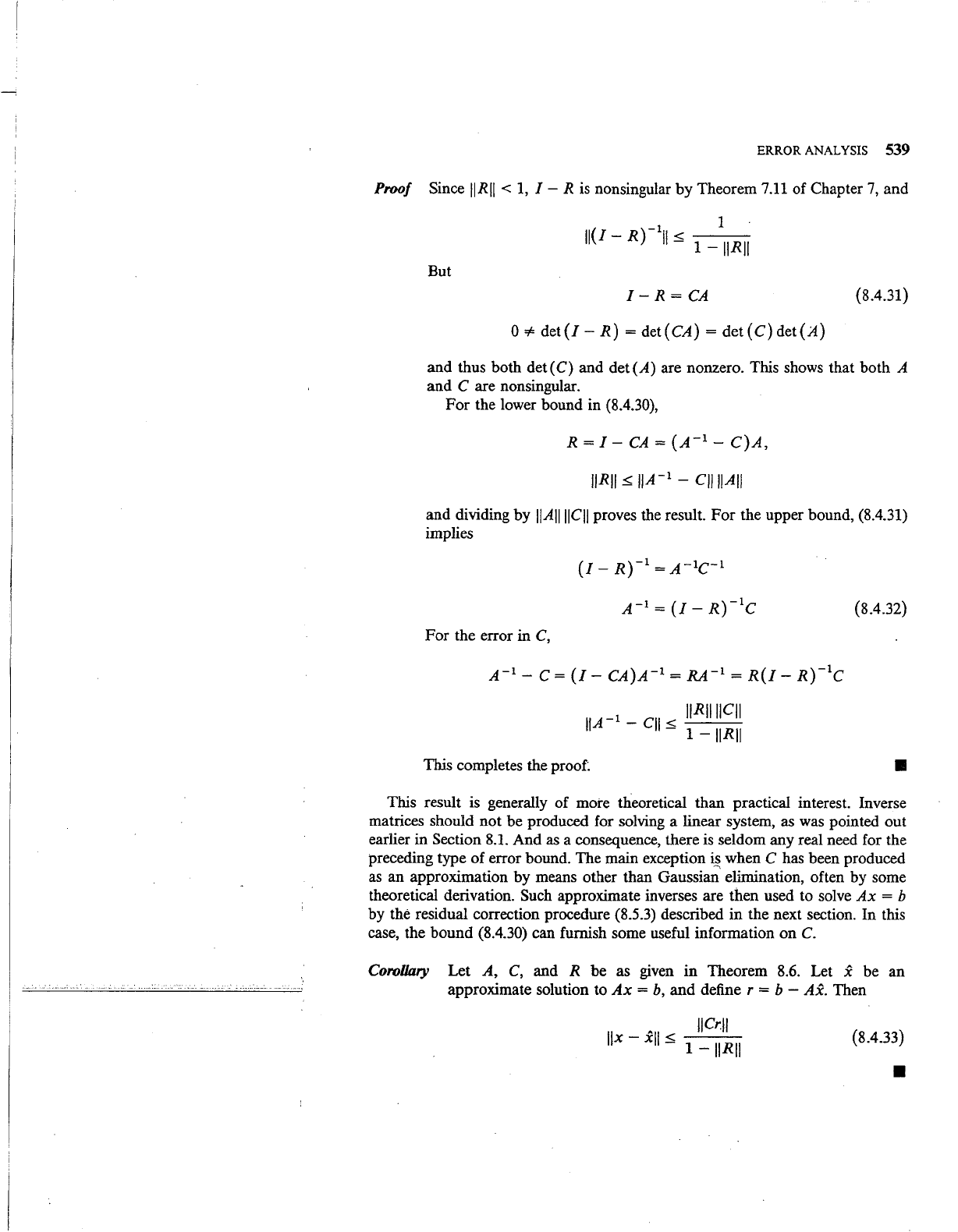
ERROR ANALYSIS 539
Proof Since
IIRII
<
1,
I-
R
is
nonsingular by Theorem
7.11
of Chapter
7,
and
But
1-R=CA
(8.4.31)
0
"4=
det
(I
-
R)
= det ( CA) =
det
(C) det (A)
and thus both
det(C)
and
det(A)
are nonzero. This shows that both A
and C are nonsingular.
For
the lower bound in (8.4.30),
R
=I-
CA
=
(A
-
1
-
C)
A,
IIRII
~
IIA-
1
-
Cll
IIAII
and dividing by
IIAII
IICII
proves the result.
For
the upper bound, (8.4.31)
implies
(I
-
R)
-1
= A
-1c-1
A-
1
=
(1-
R)-
1
C
For
the error
in
C,
A-
1
-
C =
(1-
CA)A-
1
=
RA-
1
=
R(I-
R)-
1
C
IIA-1-
Cll
<
IIRII
IICII
-
1-
IIRII
This completes the
proot
(8.4.32)
•
This result is generally of mote theoretical than practical interest. Inverse
matrices should not be produced for solving a linear system, as was pointed out
earlier in Section
8.1.
And as a consequence, there is seldom any real need for the
preceding type
of
error bound. The main exception
is
when C has been produced
as an approximation by means other than
Gaussi~
elimination, often by some
theoretical derivation. Such approximate inverses are then used to solve
Ax
= b
by the residual correction procedure (8.5.3) described
in
the next section.
In
this
case, the bound
(8.4.30) can furnish some useful information
on
C.
Corol/ary Let
A,
C,
and R be as given
in
Theorem 8.6. Let x be
an
approximate solution to
Ax=
b,
and
definer=
b-
Ax.
Then
A
IICr.ll
llx
-
xll
~
1 -
IIRII
{8.4.33)
•
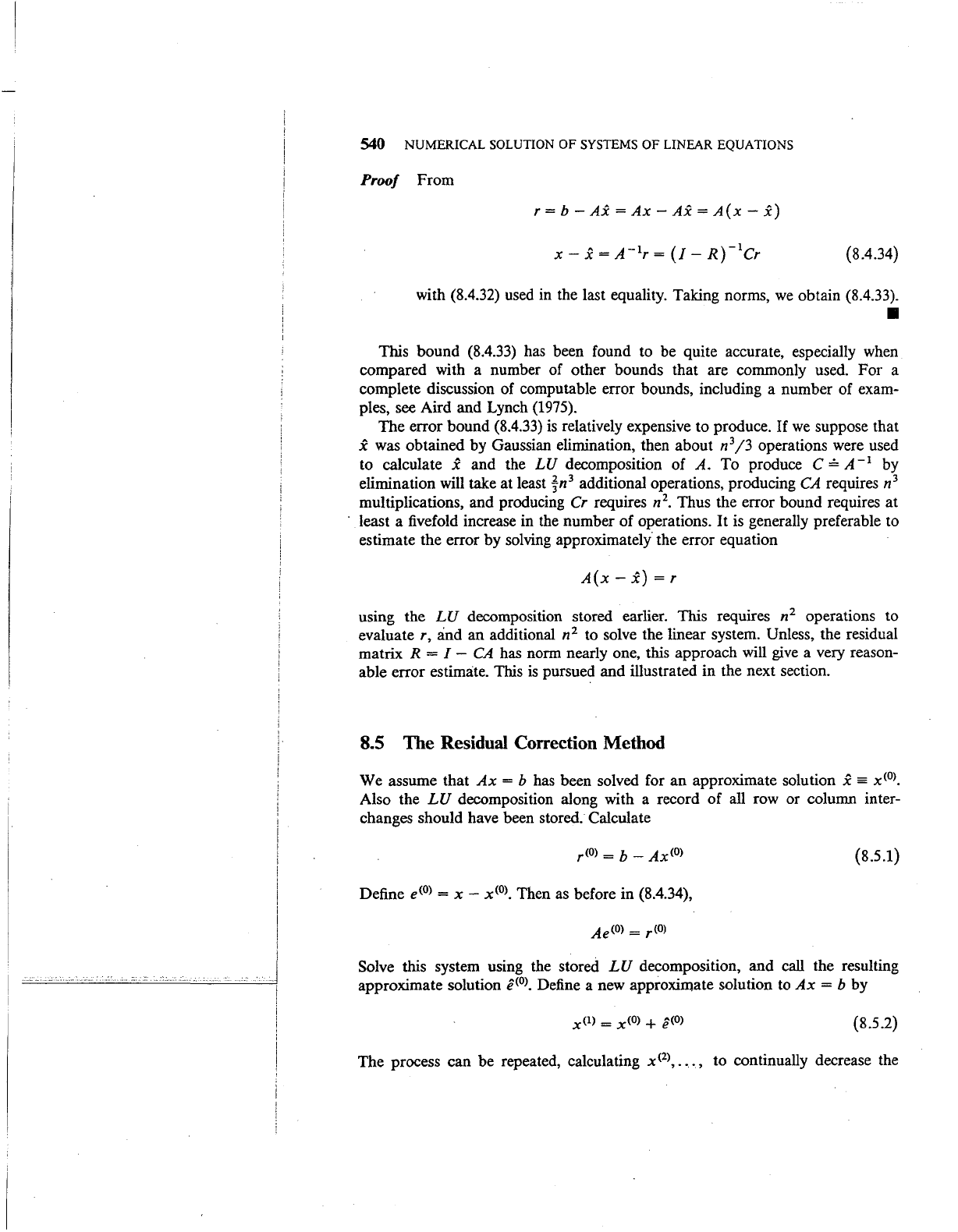
,.
,,
.
-···.
""""'··-·-
540 NUMERICAL SOLUTION OF SYSTEMS
OF
LINEAR EQUATIONS
Proof
From
r = b -
Ax
=
Ax
-
Ax
= A ( x -
:X)
(8.4.34)
with (8.4.32) used in the last equality. Taking norms,
we
obtain (8.4.33) .
•
This bound (8.4.33) has been found to be quite accurate, especially when
compared with a number of other bounds that are commonly used. For a
complete discussion of computable error bounds, including a number of exam-
ples, see Aird and Lynch
(1975).
The error bound (8.4.33)
is
relatively expensive to produce.
If
we
suppose that
:X
was obtained by Gaussian elimination, then about n
3
j3
operations were used
to calculate
:X
and the
LU
decomposition of
A.
To produce C
~
A-
1
by
elimination will take at least
fn
3
additional operations, producing
CA
requires n
3
multiplications, and producing Cr requires n
2
•
Thus the error bound requires
at
least a fivefold increase in the number of operations.
It
is generally preferable to
estimate the error by solving
approximately· the error equation
A(x-
:X)
= r
using the
LU
decomposition stored earlier. This requires n
2
operations to
evaluate
r, and an additional n
2
to solve the linear system. Unless, the residual
matrix
R = I - CA has norm nearly one, this approach will
give
a very reason-
able error
estimate. This
is
pursued and illustrated in the next section.
8.5 The Residual Correction Method
We assume that
Ax=
b has been solved for
an
approximate solution
:X=
x<
0
>.
Also the
LU
decomposition along with a record of all row or column inter-
changes should have been stored. Calculate
r<
0
> = b - Ax<
0
>
(8.5.1)
Define
e<
0
> = x -
x<
0
>.
Then
as
before in (8.4.34),
Ae<
0
> =
r<
0
>
Solve this system using the stored
LU
decomposition, and call the resulting
approximate solution
e<
0
>.
Define a new approximate solution
to
Ax
= b by
X(l)
=
X(O)
+ e(O)
(8.5.2)
The process can be repeated, calculating
x<
2
>,
.•• , to continually decrease the
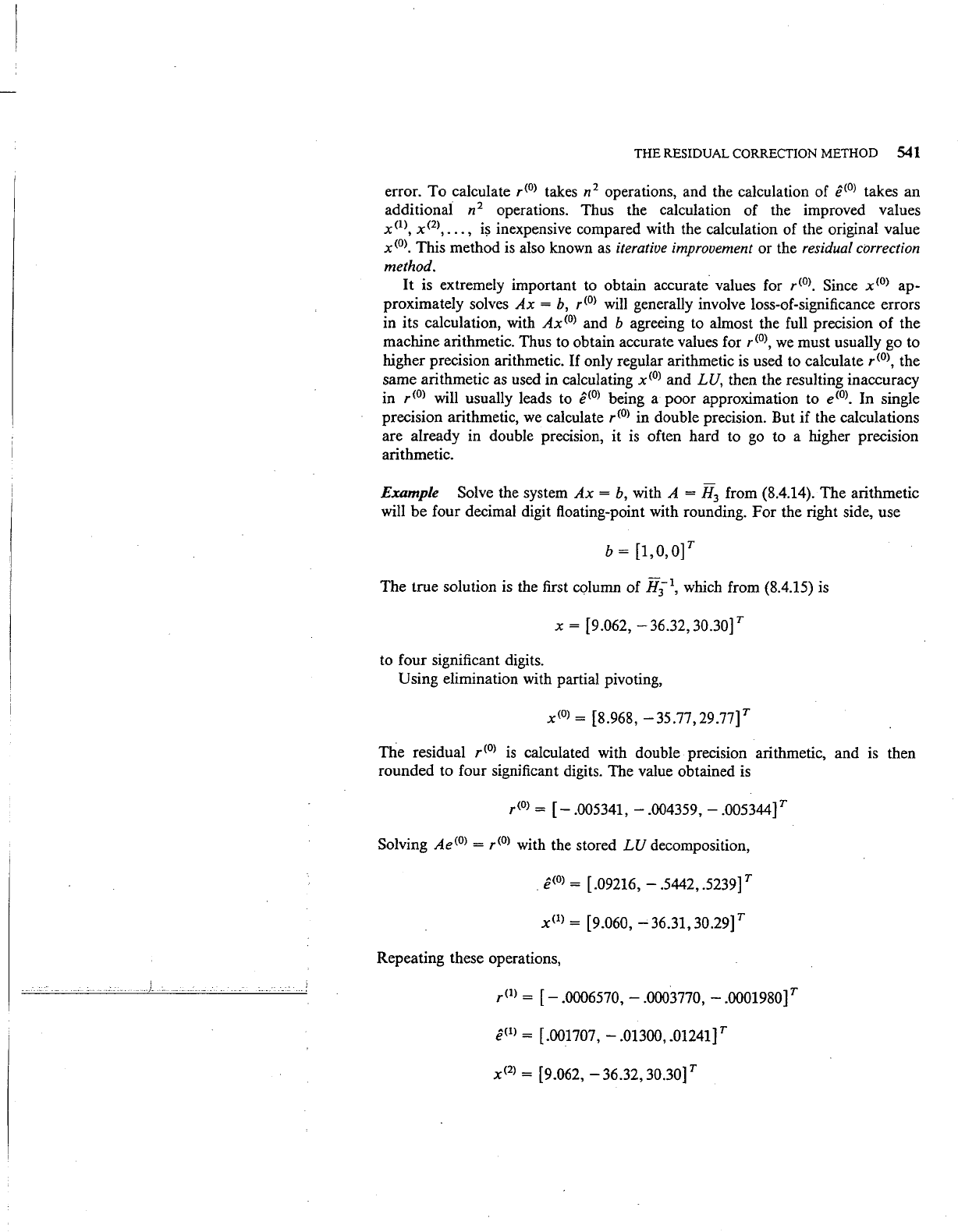
.. J ;
THE
RESIDUAL CORRECTION METHOD 541
error.
To
calculate
r<
0
> takes n
2
operations, and the calculation of
e<
0
> takes an
additional n
2
operations. Thus the calculation
of
the improved values
xO>,
x<
2
>,
••• ,
il)
inexpensive compared with the calculation of the original value
x<
0
>.
This method is also known as iterative improvement
or
the residual correction
method.
It
is extremely important to obtain accurate. values for
r<
0
>.
Since
x<
0
> ap-
proximately solves
Ax
=
b,
r<
0
> will generally involve loss-of-significance errors
in its calculation, with
Ax<
0
> and b agreeing to almost the full precision
of
the
machine arithmetic. Thus to obtain accurate values for
r<
0
>,
we
must usually go to
higher precision arithmetic.
If
only regular arithmetic is used to calculate
r<
0
>,
the
same arithmetic as used in calculating
x<
0
> and LU, then the resulting inaccuracy
in
r<O)
will usually leads to
e<O)
being a poor approximation to
e<
0
>.
In
single
precision arithmetic, we calculate
r<
0
> in double precision. But
if
the calculations
are already in double precision, it is often hard to go to a higher precision
arithmetic.
Example Solve the system
Ax=
b,
with A = H
3
from (8.4.14).
The
arithmetic
will
be
four decimal digit floating-point with rounding.
For
the right side, use
b =
[1,o,of
The true solution is the first column
of
H
3
-\
which from (8.4.15) is
x = [9.062,
-36.32,3o.3or
to four significant digits.
Using elimination with partial pivoting,
x<
0
> = [8.968,
-35.77,29.77f
The residual
r<
0
> is calculated with double precision arithmetic,
and
IS
then
rounded to four significant digits. The value obtained is
r<
0
> =
[-
.005341,-.004359,-
.005344f
Solving
Ae<
0
> =
r<
0
> with the stored
LU
decomposition,
.
e<
0
> =
[.09216,-
.5442,
.5239f
x<
1
> = [9.060, -'36.31,
30.29f
Repeating these operations,
r(l)
=
[-
.0006570, - .0003770, - .0001980] T
e<l)
= [ .001707' - .01300, .01241 r
x<
2
> = [9.062,
-36.32,
30.30f
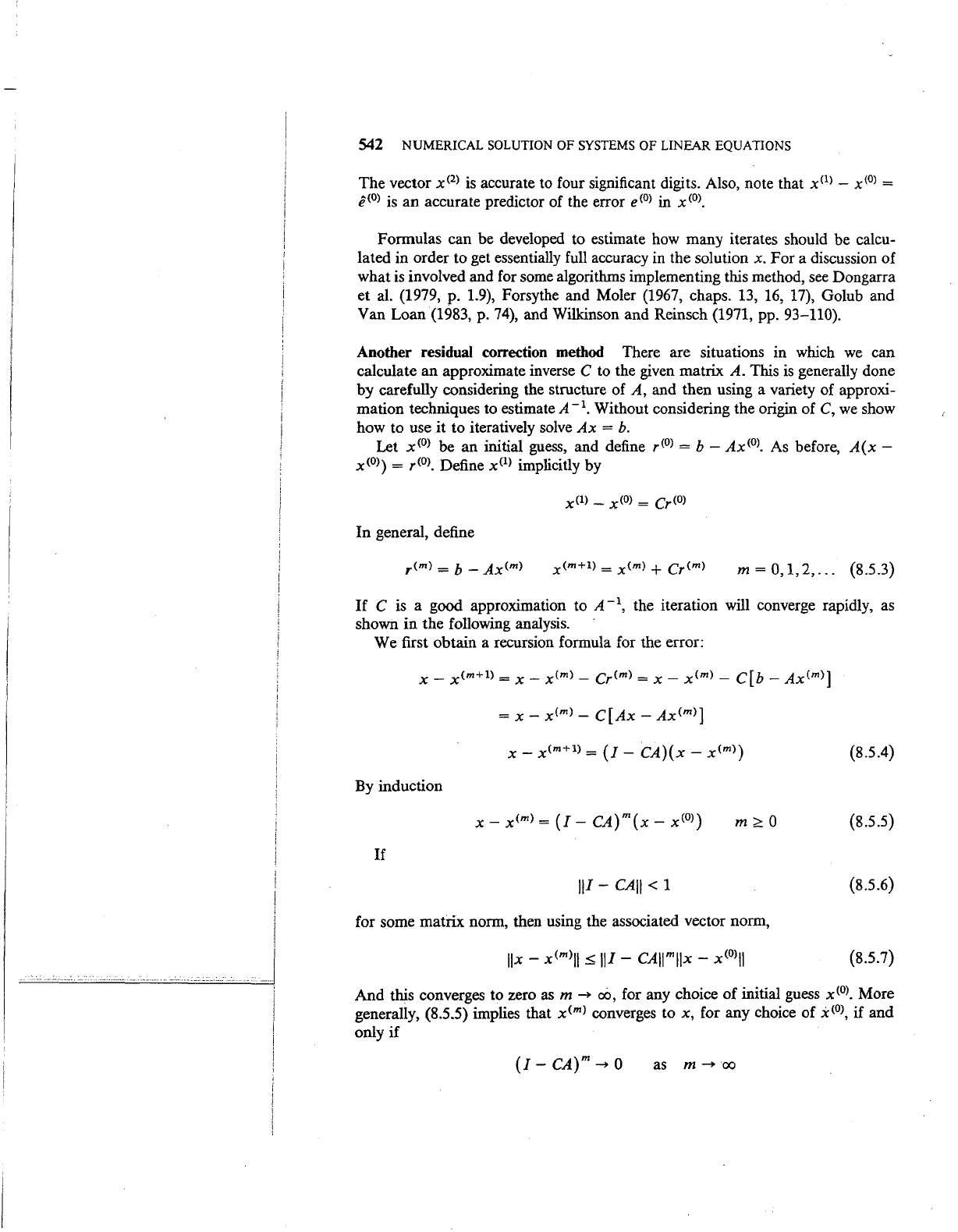
. ' . . . . . . . .
. . . .
··-·
--~
....
I
i
.
_/
542 NUMERICAL SOLUTION OF SYSTEMS OF LINEAR EQUATIONS
The
vector
x<
2
l is accurate to four significant digits. Also, note that
x<
1
> -
x<
0
> =
e<
0
> is
an
accurate predictor of the error
e<
0
> in
x<
0
>.
Formulas can
be
developed to estimate how many iterates should
be
calcu-
lated in order to get essentially full accuracy in the solution x.
For
a discussion
of
what
is involved and for some algorithms implementing this method, see Dongarra
et al. (1979, p. 1.9), Forsythe and Moler (1967, chaps. 13, 16, 17), Golub
and
Van
Loan(1983,
p. 74), and Wilkinson
and
Reinsch (1971, pp. 93-110).
Another residual correction method There are situations in which we can
calculate
an
approximate inverse C to the given matrix A. This is generally done
by
carefully considering the structure
of
A,
and then using a variety of approxi-
mation techniques to estimate A
-l.
Without considering the origin
of
C, we show
how
to
use
it
to iteratively solve
Ax
=
b.
Let
xC
0
l be
an
initial guess, and define
,col
= b -
Ax<
0
>.
As before,
A(x
-
xC
0
l)
=
rC
0
>.
Define
xC
1
l implicitly by
xCl) -
xC
0
> =
Cr<
0
>
In
general, define
rCm)
= b -
AxCm)
xCm+l)
=
xCm)
+
cr<m)
m = 0, 1,
2,...
(8.5.3)
If
C is a good approximation to A -I, the iteration will converge rapidly, as
shown
in
the
following analysis.
We first obtain a recursion formula for the error:
X-
x<m+l)
=X-
xCm)-
crCm)
=X-
x<m)-
C[b-
AxCml]
=X-
xCm)-
C[Ax-
AxCml]
x-
xCm+l)
=(I-
CA)(x-
xCml)
(8.5.4)
By induction
m
~
0 (8.5.5)
If
Ill-
CAll< 1
(8.5.6)
for some matrix norm, then using the associated vector norm,
(8.5.7)
And
this converges to zero as
m-
o6,
for any choice
of
initial guess
xC
0
>.
More
generally, (8.5.5) implies that
xCml
converges
to
x,
for any choice
of
x<
0
),
if
and
only
if
as
m-
co
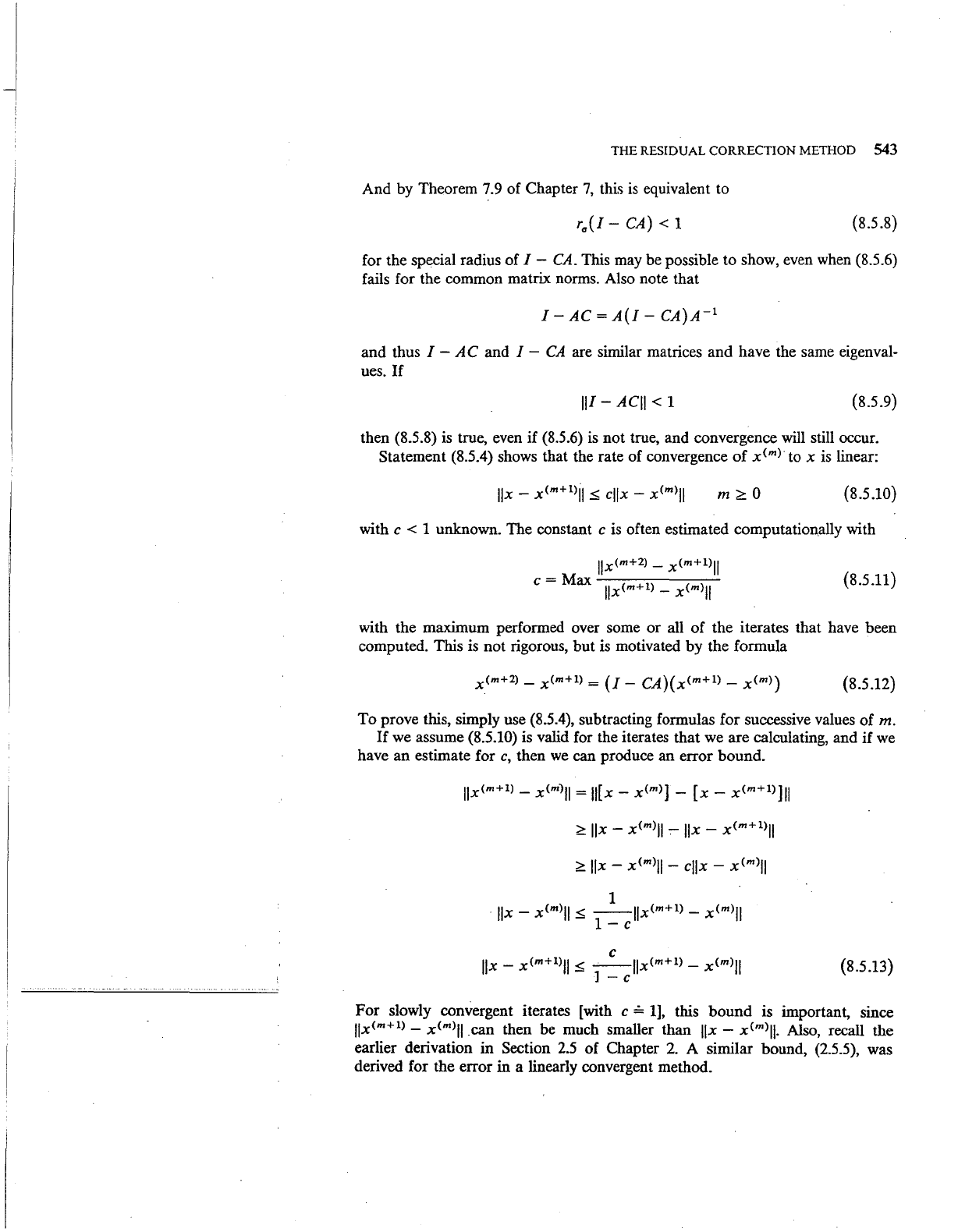
THE RESIDUAL CORRECTION METHOD 543
And by Theorem
7.9
of Chapter
7,
this
is
equivalent
to
(8.5.8)
for the special radius of I -
CA.
This may be possible to show, even
when
(8.5.6)
fails for the common matrix norms. Also note that
I-
AC
=
A(I-
CA)A-
1
and thus I - A C and I -
CA
are similar matrices and have the same eigenval-
ues.
If
Ill-
ACII
< 1
(8.5.9)
then (8.5.8)
is
true, even if (8.5.6)
is
not true, and convergence
will
still occur.
Statement
(8.5.4) shows that the rate of convergence
of
x<m>
to x is linear:
m
~0
(8.5.10)
with c < 1 unknown. The constant c
is
often estimated computationally with
(8.5.11)
with the maximum performed over some or all of the iterates that have been
computed. This is not rigorous, but is motivated by the formula
x<m+2>
_
x<m+l>
=
(I_
CA)(x<m+l>
_
x<m>)
(8.5.12)
To
prove this, simply use (8.5.4), subtracting formulas for successive values of m.
If
we assume (8.5.10) is valid for the iterates that we are calculating, and if
we
have an estimate for
c,
then
we
can produce an error bound.
nx<m+l)-
x<m)ll
=
ll[x-
x<m>]
-
[x-
x<m+l)]ll
~
nx-
x<m>ll-:-llx-
x<m+l)ll
~
llx-
x<m>u-
cllx-
x<m>ll
1
.
llx
-
x<m>u
:s;;
--ux<m+I>
-
x<m>ll
1-c
(8.5.13)
For slowly convergent iterates [with c = 1], this bound
lS
Important, since
llx<m+l)
-
x<m>ll_can
then be much smaller than llx -
x<m>n.
Also, recall the
earlier derivation in Section
2.5
of Chapter 2. A similar bound, (2.5.5), was
derived for the error in a linearly convergent method.
